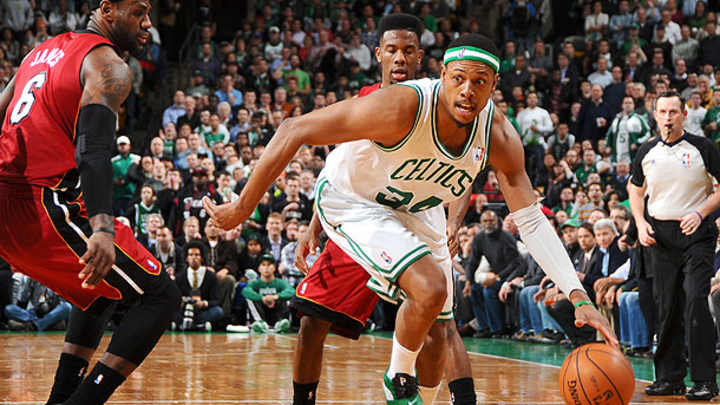Paul Pierce's understated athleticism

Paul Pierce, 35, is averaging 18.7 points, 6.3 rebounds, 4.7 assists and 1.2 steals. (Brian Babineau/NBAE via Getty Images)

By Rob Mahoney
Paul Pierce is a savvy veteran, which is a not-so-subtly coded way of noting that he's productive despite being well past his physical prime. He isn't a leaper at this age and didn't even display impressive vertical potential at his athletic peak. No one could describe Pierce's game as "explosive," without their tongue planted firmly in their cheek, and opponents won't soon fear the physical gifts of a 35-year-old wing with a notorious "old-man game."
But according to two very different quantitative measures of athleticism, Pierce bafflingly rates as one of the more athletic players in the league. At the MIT Sloan Sports Analytics Conference earlier this month, NYU-Polytechnic Institute professor Philip Maymin presented a research paper on the magnitude at which individual NBA players accelerate over the course of a game, as measured by SportVU's amazing optical tracking cameras. In tabulating how often and how much players accelerate around the court, Maymin is essentially measuring a player's athleticism, as the propulsion and speed of a player's movements provide the primary variable for his analysis. Maymin draws all kinds of conclusions from the data collected, but most relevant were his findings regarding Pierce. In the data from the 2011-12 season (the extent of Maymin's set), Pierce rated as one of the league's most frequent accelerators, comparing favorably to the likes of Kevin Durant and Dwyane Wade.
On a different note, ESPN.com's Bradford Doolittle introduced a new metric -- ATH -- on Wednesday (Insider only), designed to evaluate a player's applied athleticism as it relates to his box score contributions. In his piece, Doolittle explains his general methodology for calculating ATH:
[ATH] compares each player's percentage in rebounding, foul-drawing, blocked shots and steals to the league norms for a player of his height. The ratios are regressed for playing time and averaged together to create ATH, which is expressed as a number extended to three decimal points. The league average is 1.000, so if a player has an ATH of 1.167, that's to say his rating is 16.7 percent better than the league average. Again, the team rating is determined by the ATH scores of the players on its roster, weighted by minutes played.
It's hardly a conclusive measure of a player's natural athleticism, as Doolittle freely admits. But ATH does a sound job of accounting for the basic ways in which athleticism manifests itself most readily in the box score, save perhaps the impact it has on shot creation and scoring. Nevertheless, the leaders in ATH (Dwight Howard, Dwyane Wade, Russell Westbrook, Derrick Favors, etc.) more or less line up with conventional interpretations of athleticism ... until we get to Pierce, who is rather curiously at No. 25. Pierce's actual ATH rating is 1.187, making him 18.7 percent better than league average in this measure of athleticism, and "more athletic" than Josh Smith, Andre Iguodala, Paul George, Rajon Rondo, Michael Kidd-Gilchrist and Larry Sanders, among so many others.
That's a strange turn of the numbers, but perhaps there's more to Pierce's athleticism than some statistical coincidence. Pierce may not be able to whirl around defenders or explode to the rim, but one of the reasons why he rates among the NBA's biggest accelerators is because he uses quick, controlled bursts to take advantage of a very different kind of athleticism: the ability to stop at a moment's notice. There's no cool-down with Pierce, no stretch of deceleration. He simply starts and stops on a whim, and challenges his opponents to keep up:
The ease with which Pierce changes directions and speeds is in itself a physical ability, albeit one maximized by his guile. There's no question that Pierce understands the value of varied movement, perhaps to a deeper extent than any player in the league. But he is only so successful as a stutter-step player because he's able to shift gears constantly while maintaining perfect balance. That's an incredible physical talent, albeit one not captured by a traditional conception of athleticism that favors sprinting speed and aerial acrobatics above the more restrained flares of a player like Pierce.
Yet in practical terms, Pierce's brand of athleticism allows him to mimic the output of quick-sprinting, high-flying players through far more dynamic means. His live dribble begins as a dance, but transforms into an unpredictable deke -- a series of sways and jolts that remains impossible to pin down even after extensive film sessions. It's from that zone of zigs and zags that Pierce so often dupes his opponents, leveraging their expectations by baiting them into fouls. That's where Pierce gleans a huge advantage in terms of ATH. According to Doolittle, Pierce rated as 26.4 percent above the league average in his ability to draw fouls, which should come as little surprise to those who have seen Pierce fool even the most disciplined defenders with his drives of fits and starts.
